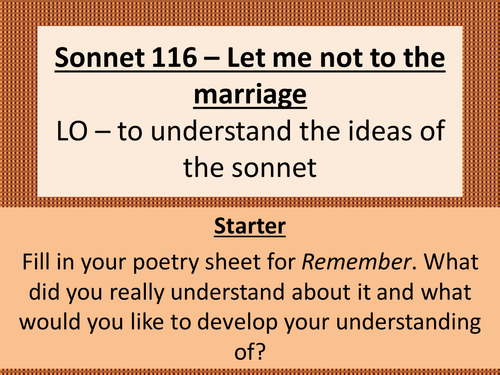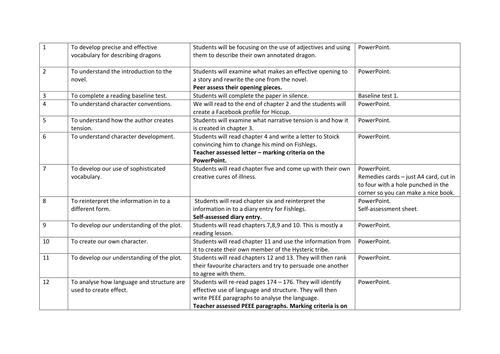
32Uploads
73k+Views
221k+Downloads
All resources

Descriptive Writing for IGCSE
A series of eight lessons for writing the descriptive writing piece for IGCSE coursework.

Year 10 Non-fiction. Producing a newspaper article
A week short focus on newspaper artciles starting off from what a newspaper is, to what different kinds of newspapers there are and eventually making their own.

Writing a film review
For the iGCSE coursework, we've decided to do a film review as one of the coursework pieces.
I&'ve made a set of four lessons to introduce film reviews and start to get students thinking about writing their own.

Hansel and Gretel Creative Writing
A creative writing lesson linked to Hansel and Gretel which focuses on using the senses.

Comparing War Poetry
A series of 5 lessons comparing two poems, Dulce et Decorum Est and Who's for the Game?

Romanticism Scheme of Work
This was a 12 lesson scheme of work written for a high ability Year 7 group. There are 11 full lessons, fully resourced, a scheme of work to follow which clearly indicates when and what assessment can take place, as well as a final writing assessment.
I found my class enjoyed studying Romanticism, predominantly because of the poets themselves. I set them out as Rockstars of the era and the students loved it.
Edit - for some reason, lesson 4 and 9 won't upload, so if you drop me a message, I will send them to you directly.

One off Literacy lesson - Mortal Instruments
This is a one off literacy lesson, based around an extract from the Mortal Instruments series. It focuses on understanding next words through using the context.

Vampire History lesson - Dracula Play - David Calcutt
A lesson focusing around the context of vampires in literature in preparation for studying Calcutt's play of Dracula.
It is a group research based lesson, where students will work in groups to work through the various research pods. They will then write a paragraph about context which will be peer assessed.
Delivered to a high ability year 7 group.

AQA Paper 2 Section B - articles
6 half hour lessons on developing skills for writing an article for AQA section B.

The Context of Hansel and Gretel
This lesson looks at different versions of the Hansel and Gretel tale.

2 Ofsted lessons examining For the Fallen
Two year 8 lessons designed for an Ofsted visit.
The first lesson concerns understanding the importance of Remembrance and understanding the poem.
The second lesson is focused around analysing the language.
Group work.
Peer assessment.
Success criteria.
Independent research.
SMSC and British Values included.

Independent media task
An independent media task where students are to create an anti bullying campaign.
Designed for top set year 8.

IGCSE Question 2
A lesson planned for an observation, focusing on Question 2 of the English IGCSE.
LO – to apply our understanding of question two and create a response to an exam question.
There are a range of resources provided as well as a lesson plan which will just need details and differentiation filled in.

KS3 Complete scheme of work - How to Cheat a Dragon's Curse
A scheme of work designed for Year 7. The scheme includes assessments, 16 complete lessons, a baseline reading test, homeworks and all resources (aside from the actual novel).
Below is an extract from the SoW, with the LOs, outline of the lesson and resources, as well as assessment.
1-To develop precise and effective vocabulary for describing dragons . Students will be focusing on the use of adjectives and using them to describe their own annotated dragon. PowerPoint.
2-To understand the introduction to the novel. Students will examine what makes an effective opening to a story and rewrite the one from the novel. Peer assess their opening pieces. PowerPoint.
3-To complete a reading baseline test. Students will complete the paper in silence. Baseline test 1.
4-To understand character conventions. We will read to the end of chapter 2 and the students will create a Facebook profile for Hiccup. PowerPoint.
5-To understand how the author creates tension. Students will examine what narrative tension is and how it is created in chapter 3. PowerPoint.
6-To understand character development. Students will read chapter 4 and write a letter to Stoick convincing him to change his mind on Fishlegs. Teacher assessed letter – marking criteria on the PowerPoint. PowerPoint.
7-To develop our use of sophisticated vocabulary. Students will read chapter five and come up with their own creative cures of illness. PowerPoint. Remedies cards – just A4 card, cut in to four with a hole punched in the corner so you can make a nice book.
8-To reinterpret the information in to a different form. Students will read chapter six and reinterpret the information in to a diary entry for Fishlegs. Self-assessed diary entry. PowerPoint. Self-assessment sheet.
9- To develop our understanding of the plot. Students will read chapters 7,8,9 and 10. This is mostly a reading lesson. PowerPoint.
10-To create our own character. Students will read chapter 11 and use the information from it to create their own member of the Hysteric tribe. PowerPoint.
11-To develop our understanding of the plot. Students will read chapters 12 and 13. They will then rank their favourite characters and try to persuade one another to agree with them. PowerPoint.
12-To analyse how language and structure are used to create effect. Students will re-read pages 174 – 176. They will identify effective use of language and structure. They will then write PEEE paragraphs to analyse the language. Teacher assessed PEEE paragraphs. Marking criteria is on the PowerPoint. PowerPoint.

KS3 Complete scheme of work for Dracula (The Play by David Calcutt)
This is entire scheme of work with 14 fully resourced hour lessons, 5 half hour lessons, which include dedicated improvement time, an assessment as well as homework to set weekly. There is also an overview of the scheme with specified tasks to mark, as well as peer assess and self assess. Each lesson includes self starters, a main task or three and a plenary. SMSC is also referred to.
This is pretty much a download and deliver scheme.
It was written for a high ability year 7 but could easily be used for year 8 too.
I have included a brief overview on the first 6 lessons below.
1 - To understand the unit of work and the context. Students will create targets for the next scheme of work based on AO2 and AO4 of the GCSE language assessment objectives. They will also work in groups to answer questions about the context of the play. Resources - PowerPoint. Target sheets. Research pack.
2 - To analyse language. Students will examine an extract from the original Dracula text and write a PEEE paragraph about the way that Stoker has presented the character. PEEE paragraph to be marked. Resources - PowerPoint. Dracula extract.
3 - To analyse language and make predictions based on the text. Students will examine the prologue of the text and draw conclusions about Dracula. There is also a discussion about the importance of perspectives as they will compare this presentation of Dracula to that of Stoker. Resources - PowerPoint. Dracula texts.
4 - To understand and analyse Scene 1. Students will read the first scene of the play as a group. There is quite a lot of discussion in this lesson about drawing conclusions from the text. Resources - PowerPoint.
5 - To understand the scene and the feelings of the characters Students will read the second scene in the play. They will then need to write a letter from Mina to Jonathon for which there is a success criteria.
Letter to be marked. Resources - PowerPoint.
6 - To understand and summarise Act 1. Students will read scenes 3 and 4 of Act 1. They will be introduced to foreshadowing. They will summarise the act and discuss the effect of having two stories running parallel. Resources - PowerPoint.




















